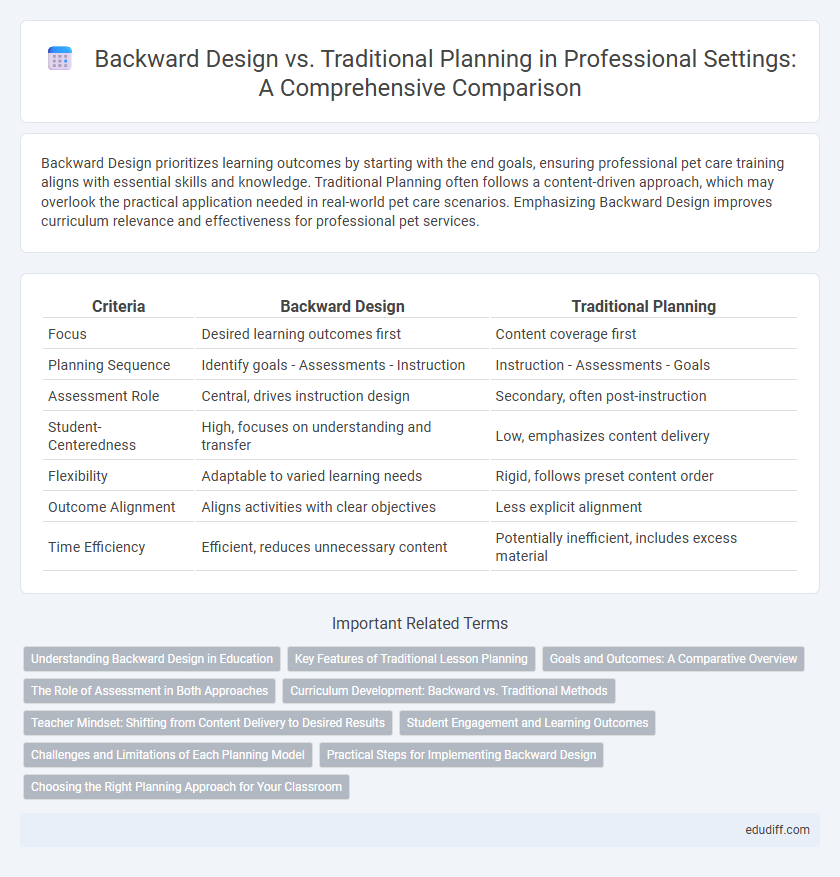Backward Design prioritizes learning outcomes by starting with the end goals, ensuring professional pet care training aligns with essential skills and knowledge. Traditional Planning often follows a content-driven approach, which may overlook the practical application needed in real-world pet care scenarios. Emphasizing Backward Design improves curriculum relevance and effectiveness for professional pet services.
Table of Comparison
| Criteria | Backward Design | Traditional Planning |
|---|---|---|
| Focus | Desired learning outcomes first | Content coverage first |
| Planning Sequence | Identify goals - Assessments - Instruction | Instruction - Assessments - Goals |
| Assessment Role | Central, drives instruction design | Secondary, often post-instruction |
| Student-Centeredness | High, focuses on understanding and transfer | Low, emphasizes content delivery |
| Flexibility | Adaptable to varied learning needs | Rigid, follows preset content order |
| Outcome Alignment | Aligns activities with clear objectives | Less explicit alignment |
| Time Efficiency | Efficient, reduces unnecessary content | Potentially inefficient, includes excess material |
Understanding Backward Design in Education
Backward Design in education centers on identifying desired learning outcomes before planning instructional activities, ensuring alignment with assessment goals and enhancing instructional coherence. Unlike Traditional Planning, which often begins with selecting teaching methods or content, Backward Design prioritizes end goals to promote deeper understanding and mastery. This approach improves curriculum effectiveness by focusing on what students need to know and be able to do, leading to targeted and purposeful teaching strategies.
Key Features of Traditional Lesson Planning
Traditional lesson planning centers on sequencing content based on curriculum standards and teacher expertise, emphasizing daily activities and instructional methods. It typically follows a linear progression from objectives to instruction and assessment without explicitly aligning tasks to desired learning outcomes. This approach can lack the backward mapping of goals to assessments, often resulting in less targeted and flexible lesson structures.
Goals and Outcomes: A Comparative Overview
Backward Design prioritizes defining clear learning goals and desired outcomes before planning instructional activities, ensuring alignment throughout the curriculum. Traditional Planning often begins with content coverage, risking a disconnect between teaching methods and intended student achievements. Emphasizing measurable outcomes in Backward Design enhances assessment accuracy and promotes targeted skill development.
The Role of Assessment in Both Approaches
Assessment in Backward Design serves as the foundation for curriculum development, guiding the creation of learning activities to achieve clearly defined outcomes, while in Traditional Planning, assessment typically follows instruction as a means to evaluate student understanding. Backward Design emphasizes formative and summative assessments aligned with targeted skills and knowledge, ensuring continuous feedback guides instructional adjustments. In contrast, Traditional Planning often relies on summative assessments to measure content retention after teaching, limiting opportunities for iterative instructional improvements.
Curriculum Development: Backward vs. Traditional Methods
Backward design in curriculum development prioritizes defining desired learning outcomes before planning instructional methods and assessments, ensuring alignment with educational goals. Traditional planning often begins with selecting content and activities without explicitly identifying end goals, which can lead to less focused instruction. Emphasizing backward design enhances curriculum coherence, promotes mastery of essential skills, and improves student performance metrics.
Teacher Mindset: Shifting from Content Delivery to Desired Results
Teachers adopting backward design prioritize identifying desired learning outcomes before planning lessons, fostering a results-driven mindset rather than focusing solely on content delivery. This approach encourages educators to align assessments and instructional activities directly with learning goals, enhancing student understanding and retention. Shifting the teacher mindset to emphasize end goals over content coverage transforms curriculum planning into a more purposeful, student-centered process.
Student Engagement and Learning Outcomes
Backward Design prioritizes defining desired learning outcomes before planning instruction, which directly enhances student engagement through targeted activities and assessments. Traditional planning often focuses on content delivery first, potentially leading to misalignment between teaching methods and student needs, thereby reducing engagement. Research indicates that Backward Design improves learning outcomes by fostering deeper understanding and active participation.
Challenges and Limitations of Each Planning Model
Backward Design may face challenges such as difficulty aligning assessments with learning outcomes and the initial time investment needed to clearly define goals. Traditional Planning often struggles with a lack of focus on desired results, leading to potential misalignment between activities and objectives, which can hinder effective measurement of student progress. Both models require careful adaptation to specific educational contexts to overcome limitations related to flexibility and comprehensive curriculum coverage.
Practical Steps for Implementing Backward Design
Start by clearly defining desired learning outcomes and assessment criteria before planning instructional activities. Develop authentic assessments that align with these goals, ensuring each task measures key competencies. Create lesson plans that directly support students' progress toward mastering identified objectives through targeted activities and resources.
Choosing the Right Planning Approach for Your Classroom
Backward Design emphasizes starting with learning outcomes and assessments to guide instructional planning, ensuring clarity and alignment with educational goals. Traditional Planning often focuses on covering content chronologically, which can lead to gaps in assessing student understanding and mastery. Selecting the right planning approach depends on the desired emphasis on student-centered outcomes versus content delivery, with Backward Design encouraging deeper engagement and more effective assessment strategies.
Backward Design vs Traditional Planning Infographic

 edudiff.com
edudiff.com